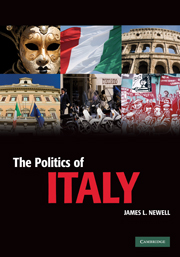Book contents
- Frontmatter
- Contents
- List of figures
- List of maps
- List of tables
- List of boxes
- Acknowledgements
- List of abbreviations
- Chronology
- Map 1 Italian regions and major cities
- Introduction
- I Historical background
- II The polity: structures and institutions of the regime
- III Politics: citizens, elites and interest mediation
- 5 Political culture and behaviour
- 6 Interests and interest mediation: voluntary associations and pressure groups
- 7 Elections, voting and political parties
- IV Policies and performances
- Appendix: The electoral system for the Chamber of Deputies and the Senate
- References
- Index
5 - Political culture and behaviour
Published online by Cambridge University Press: 05 August 2012
- Frontmatter
- Contents
- List of figures
- List of maps
- List of tables
- List of boxes
- Acknowledgements
- List of abbreviations
- Chronology
- Map 1 Italian regions and major cities
- Introduction
- I Historical background
- II The polity: structures and institutions of the regime
- III Politics: citizens, elites and interest mediation
- 5 Political culture and behaviour
- 6 Interests and interest mediation: voluntary associations and pressure groups
- 7 Elections, voting and political parties
- IV Policies and performances
- Appendix: The electoral system for the Chamber of Deputies and the Senate
- References
- Index
Summary
Introduction
In the last chapter we looked at how policy is made through the institutions of Parliament, the executive and the public administration. A focus on institutions (Box 5.1) and how they function can provide insight into a wide range of political processes. This is because the rules and procedures embodied in institutions exercise a powerful influence on the behaviour of individuals. Political scientists see this influence taking place in one or other of two ways. That is, from what is known as the ‘behaviouralist’ perspective (Box 5.1), rules and procedures influence individuals' behaviour because they define institutional roles and stipulate norms (which individuals internalise) concerning how role incumbents ought to act. Alternatively, from a ‘rational choice’ perspective (Box 5.1), they do it by structuring (a) the alternative political goals that are available to individuals to pursue, and (b) the resources available to them.
However, a focus on institutions can only get one so far. In particular, if our attention remains confined to the formal properties of institutions, it is likely that we will come to understand little of how politics – the acquisition, retention and relinquishing of power – actually takes place through those institutions. Accordingly, the focus of our attention in this chapter shifts to another dimension of political behaviour, the cultural dimension.
- Type
- Chapter
- Information
- The Politics of ItalyGovernance in a Normal Country, pp. 145 - 178Publisher: Cambridge University PressPrint publication year: 2010

